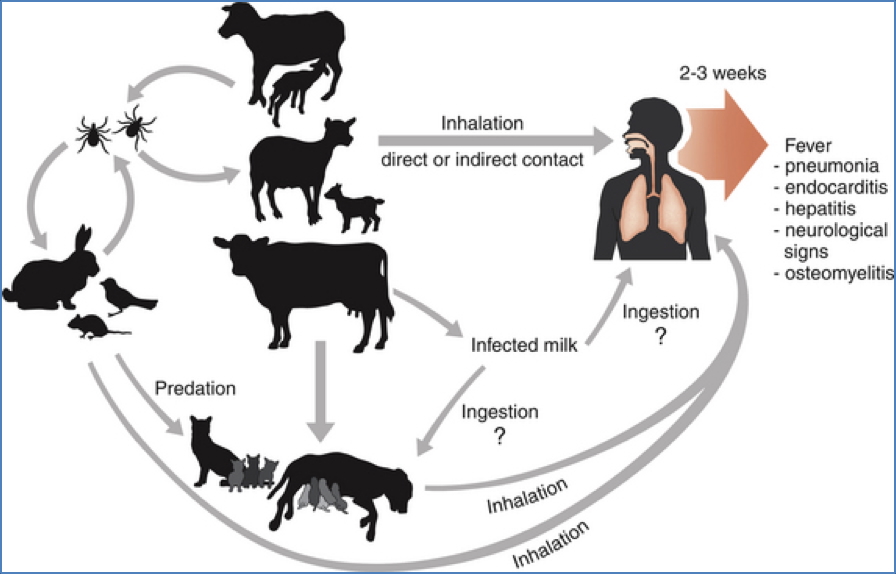Table of Contents
Overview – Q Fever
Q Fever is a zoonotic bacterial infection caused by Coxiella burnetii, commonly transmitted to humans via inhalation of aerosolised animal secretions or contact with contaminated materials. It primarily affects those in close contact with livestock (e.g. abattoir workers, farmers, veterinarians) and presents as an acute febrile illness or, more insidiously, as chronic endocarditis. While often self-limiting, it may progress to severe pneumonia, hepatitis, or chronic Q fever. This page outlines the essential clinical features, diagnostic strategies, and management guidelines for medical students and clinicians.
Definition
Q Fever is a zoonotic bacterial infection caused by Coxiella burnetii, typically affecting individuals exposed to livestock or contaminated animal products.
Aetiology
- Coxiella burnetii
- An obligate intracellular Gram-negative bacterium
- Found in cattle, sheep, goats, and other domestic mammals (including cats and dogs)
Transmission
- Inhalation of aerosolised endospores
- Direct contact with:
- Unpasteurised milk
- Urine or faeces of infected animals
- High-risk settings: farms, abattoirs, veterinary environments
Pathogenesis
- Incubation period: 2–3 weeks
- Two-phase disease:
- Acute: flu-like symptoms and respiratory involvement
- Chronic: may be asymptomatic for years; can manifest as endocarditis or chronic fatigue syndrome
Clinical Features
- Constitutional: abrupt fever, chills, sweats, malaise
- Respiratory: dry cough, pleuritic chest pain
- Gastrointestinal: nausea, vomiting, diarrhoea
- Neurological: headache, confusion (rare)
- Musculoskeletal: myalgia, arthralgia

Investigations
- Serology: detection of phase II IgM and IgG antibodies
- PCR: useful for early detection in acute cases
- Liver function tests (LFTs): raised ALT/AST
- Transthoracic or transoesophageal echocardiogram (TTE/TOE): if endocarditis suspected
Management
- Antibiotic of choice:
- Doxycycline for 14 days in acute disease
- Chronic Q fever (e.g. endocarditis) may require prolonged doxycycline + hydroxychloroquine
- Supportive care as needed (e.g. fluids, antipyretics)
Complications
- Atypical pneumonia → acute respiratory distress syndrome (ARDS)
- Granulomatous hepatitis → hepatomegaly, right upper quadrant pain
- Chronic Q Fever:
- Most feared: endocarditis
- Can also lead to osteomyelitis or chronic fatigue syndrome
Prevention
- Q-Vax (whole-cell inactivated vaccine) available in Australia
- Administered intradermally
- Pre-vaccination screening essential (skin and blood test) to avoid adverse reaction in immune individuals
- Targeted at:
- Abattoir workers
- Farmers
- Veterinarians
- Animal handlers
Differential Diagnosis
- Influenza
- Community-acquired pneumonia (especially atypical)
- Viral hepatitis
- Infectious mononucleosis
- Tuberculosis (in chronic presentation)
Summary – Q Fever
Q Fever is a zoonotic infection caused by Coxiella burnetii, typically acquired via inhalation of animal excreta. While many infections are mild and self-limited, complications such as pneumonia, granulomatous hepatitis, and chronic endocarditis can be life-threatening. Diagnosis is largely serological, and treatment with doxycycline is effective. For broader context, visit our Microbiology & Public Health page.